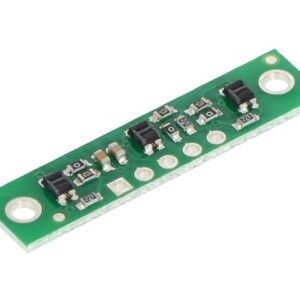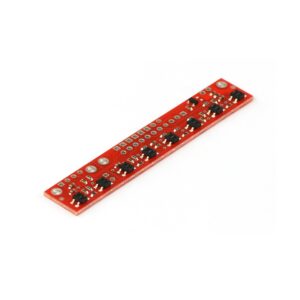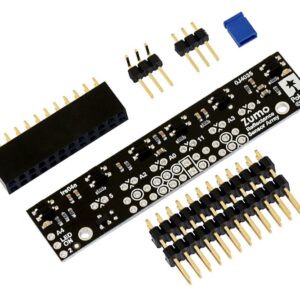ATENCIÓN: Durante Diciembre los días sábado no habrá servicio. Descartar
Ir al contenido$220.00 MXN (IVA Incluido)
4 disponibles
Este módulo QTR-3RC es compacto, contiene un paquete de tres IR LED/fototransistor en pares dentro de una placa de 1,25″x 0,3″. Los sensores están montados en un paso de 0,375″.
Cada sensor proporciona una salida de tensión analógica separada.
Localización: C3
| Peso | 0.02 kg |
|---|---|
| Fabricante | Pololu |
| Descuento | 5 o más $209.00 |
4 disponibles
The QTR-3RC reflectance sensor array is intended as a line sensor, but it can be used as a general-purpose proximity or reflectance sensor. The module is a convenient carrier for three IR emitter and receiver (phototransistor) pairs. With sensors spaced at intervals of 0.375″ (9.525 mm) along of the board’s longer axis, this array works well as a minimal detector for line-following robots, as line-following courses are commonly made using 3/4″ (19 mm) black electrical tape. The middle sensor is slightly offset along the short axis of the board.
To use a sensor, you must first charge the output node by applying a voltage to its OUT pin. You can then read the reflectance by withdrawing the externally supplied voltage and timing how long it takes the output voltage to decay due to the integrated phototransistor. Shorter decay time is an indication of greater reflection. This measurement approach has several advantages, especially when multiple units are used:
For an alternative array with eight sensors and the ability to turn off the IR LEDs to limit power consumption, consider ourQTR-8RC reflectance sensor array. For individual reflectance sensors, consider our QTR-1RC and QTR-L-1RC.
The QTR-3RC module has three identical sensor outputs that, like the Parallax QTI, require a digital I/O line capable of driving the output line high and then measuring the time for the output voltage to decay. The typical sequence for reading a sensor is:
These steps can typically be executed in parallel on multiple I/O lines.
With a strong reflectance, the decay time can be as low as several dozen microseconds; with no reflectance, the decay time can be up to a few milliseconds. The exact time of the decay depends on your microcontroller’s I/O line characteristics. Meaningful results can be available within 1 ms in typical cases (i.e. when not trying to measure subtle differences in low-reflectance scenarios), allowing up to 1 kHz sampling of all three sensors.
Our Pololu AVR library provides functions that make it easy to use these sensors with our Orangutan robot controllers; please see the QTR Reflectance Sensors section of our library command reference for more information. We also have aArduino library for these sensors.
This module has two mounting holes intended for #2 screws (not included); if the mounting holes are not needed, the ends of the PCB can be ground off to make the unit even smaller (less than 1″ wide). The reflectance sensor array ships with a 1×5 straight male header strip and a1×5 right-angle male header strip as shown below. You can also solder wires, such as ribbon cable, directly to the pads for the smallest installation.





